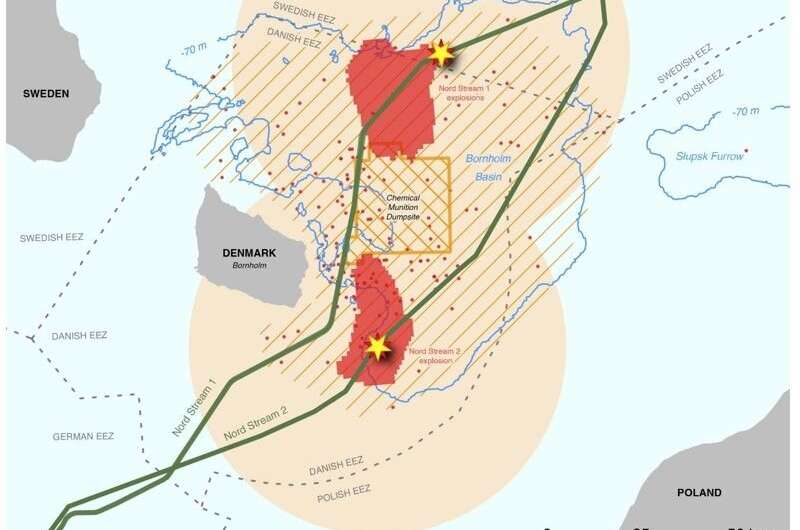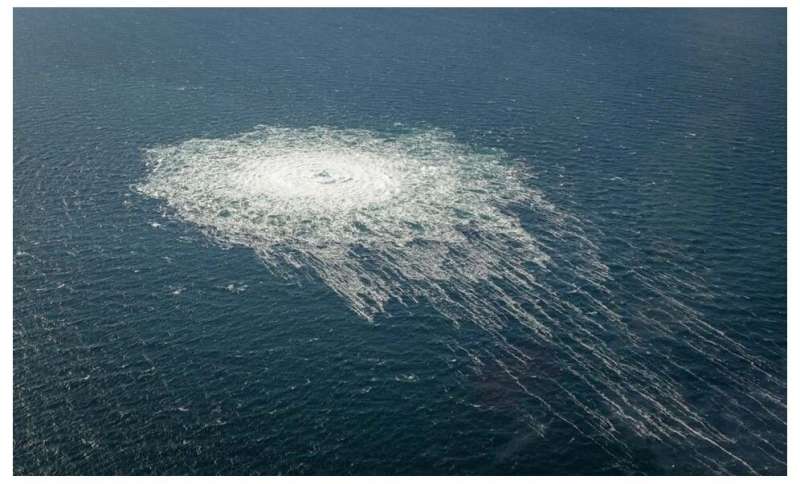
It is a matter of current international intrigue and investigation—in late September of 2022, an unknown group, organization or state successfully sabotaged two gas pipelines more than 80 meters below the Baltic Sea, severing a multibillion-dollar energy conduit from Russia to Germany. While the global political and economic concerns may be obvious, the potential environmental impacts of the event are discussed in a preprint paper made available on Research Square. The study, led by researchers at Aarhus University in Denmark, is titled “Environmental impact of sabotage of the Nord Stream pipelines.”
The explosions took place near the Danish Island of Bornholm in the Baltic Sea. It has previously been estimated that more than 115,000 tons of natural gas escaped the damaged pipeline in just six days, with a greenhouse gas contribution of approximately 15 million tons of CO2—or the amount of carbon that can be absorbed by roughly 580 million trees in a year.
The Danish-led team focused on more local environmental impacts on Baltic sea life. The researchers point out that seals and porpoises within a radius of 4 km would be at high risk of being killed by the explosion’s shockwave, with temporary impacts on hearing expected up to 50 km away.
The area is home to a harbor porpoise population of about 500 individuals. While the species is doing well in some parts of the world, it is critically endangered in the Baltic Sea. Injury to even a single individual, especially if it is an adult female, would significantly impact the population.
A terrible location
Bornholm is a beautiful island getaway of the Scandinavian variety, with iconic ruins, and warm summer weather, making it a popular holiday and tourist destination. The waters in the surrounding Baltic Sea are relatively calm, the deep water is stratified, and the sea floor is a stable environment that rarely experiences currents large enough to resuspend sediments. Precisely because it has remained largely undisturbed, it has built up heavy metal contaminants for most of industrialized human history.

Danish seismic monitoring equipment on the island of Bornholm detected the equivalent of a 500 kg TNT explosion in the sabotage event. The explosion and pipe rupture resulted in the resuspension of 250,000 metric tons of this heavily contaminated sediment. The resulting plume posed risks to fish and other sea life across a 1,200 km2 area, exceeding toxic environmental thresholds for more than a month.
Additionally, 11,000 tons of chemical warfare agents were dumped at sea in the region at the end of the Second World War, so the event is potentially disturbing an extremely hazardous site. Explosions of Nordstream 1 and Nordstream 2 pipelines occurred north and south of the main deep sea dumpsite, and construction of the pipeline incurred significant expenses in routing around the location. During construction, care was taken to limit the dispersion of seafloor sediment in the areas surrounding the chemical waste.
Records of 39 samples taken 20 km from the explosion site contain measurable chemical weapon agents, both arsenic and mustard gas related. The highest concentrations of these and other heavy metal pollutants rest in just the top 5 cm of sediment, suggesting that even a small seafloor disturbance could release a maximum amount of hazardous material into the water column. Based on the concentration, the rupture likely caused the resuspension of 34.6 tons of chemical weapon residues.
Based on sediment resuspension estimates, the most prominent toxin dispersed would be tributyltin, a once common, now banned chemical used as a biocide agent in the paint of ship hulls to prevent damage from aquatic organisms. Past studies have linked tributyltin to harm in sea mammals and toxic concentrations in fish, leading to its eventual ban. The next most significant contributing toxin based on estimation models was lead.
The sediment disruption event occurred at the end of the regular Eastern Baltic cod spawning season and could have affected eggs and juvenile cod in the area. According to the researchers, the most likely long-term impact would be endocrine disruption due to tributyltin exposure. Elevated lead exposure may induce oxidative stress, affect biochemical and physiological functions, cause neurotoxicity and disrupt the immune system.
The good news is that researchers found no significant lasting marine impacts from the natural gas release itself, and chemical residues from the explosives would represent a negligible toxic risk. However, the location of the explosions could not have been worse for exposing marine life to the hidden dangers once locked away in toxic seafloor sediments.
More information: Hans Sanderson et al, Environmental impact of sabotage of the Nord Stream pipelines, Research Square (2023). DOI: 10.21203/rs.3.rs-2564820/v1
Source – https://phys.org/news/2023-03-hidden-environmental-danger-nordstream-pipeline.html
